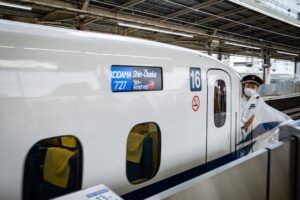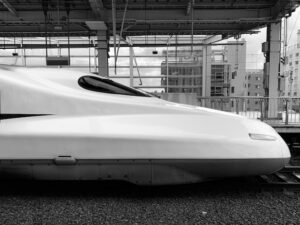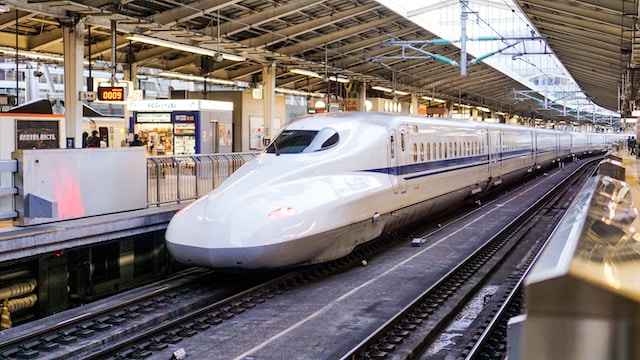The Shinkansen, known as the Japanese bullet train, is a landmark in transportation history and an engineering marvel. In this article, we will explore the exciting story behind the Shinkansen, from its humble beginnings to its evolution as the world’s most advanced high-speed rail system. Join us on this journey back in time through the history of the Shinkansen.
The Showa era and the need for a transportation revolution

The Showa era in Japan and transportation challenges
The Showa era in Japan, from 1926 to 1989, was a period of political, social and economic change, with challenges in transportation. Rapid industrialization and urbanization created congestion and inefficiency on existing roads and railways.
In addition, the need to efficiently connect the country’s regions and reconstruction after World War II prompted the development of the Shinkansen, a high-speed train that became a symbol of progress and self-improvement in the Showa era.
The construction project and the objectives behind the development of the Shinkansen
The Shinkansen project was an ambitious effort that sought to create a high-speed and efficient rail transportation system in Japan.
The main objectives were to overcome the challenges of congestion and long travel times, improve rail infrastructure, implement technological innovations, ensure safety, and have a positive economic and social impact. The result was the creation of a flagship system that revolutionized high-speed transportation worldwide.
The inauguration of the first Shinkansen in 1964: The Tokaido Shinkansen Line
The inauguration of the Shinkansen in 1964 marked a milestone in the history of transportation in Japan. The ceremony was attended by Emperor Hirohito, who officially marked the opening of the Tokaido Line.
The bullet trains, with their aerodynamic design and high speed of up to 210 km/h, impressed the public and became an instant success. The Shinkansen transformed the way people traveled in Japan, generating significant economic and social impact by boosting development and facilitating business and tourism travel. Since then, the Shinkansen has become an iconic symbol of progress and technological innovation in Japan.
The revolutionary impact of the Shinkansen
The transformation of Japan’s transportation system and its influence on the world
The Shinkansen has transformed the transportation system in Japan and has exerted significant global influence. It introduced high-speed trains, improved infrastructure and adopted innovative technologies.
Its success has led to international collaboration and has influenced the development of high-speed rail systems around the world. The Shinkansen is recognized as a model of efficiency and sustainability in transportation.
Economic, Social and Environmental Benefits of the Shinkansen
The Shinkansen has brought economic, social and environmental benefits. It has stimulated economic growth by improving connectivity between cities, improved people’s quality of life by providing fast and convenient transportation, and helped reduce congestion and greenhouse gas emissions.
Overall, the Shinkansen is considered an exemplary model of sustainable development in transportation.
International recognition and export of Shinkansen technology
The Shinkansen, or Japanese bullet train, has gained international recognition as an outstanding achievement in transportation technology. Several countries have shown interest in adopting and adapting Shinkansen technology for their own high-speed rail systems.
Japan has successfully exported its experience and expertise in the construction and operation of the Shinkansen, which has led to the implementation of similar systems in countries such as France, Taiwan and China. The export of Shinkansen technology has strengthened trade ties and boosted Japan’s technological prestige worldwide.
The evolution and expansion of the Shinkansen

Technological improvements and the introduction of new generations of bullet trains
Over the years, the Shinkansen has undergone significant technological improvements and the introduction of new generations of bullet trains. These improvements have increased the speed, efficiency and comfort of the system. Advances have been implemented in aerodynamics, propulsion and braking systems, as well as in safety and noise reduction.
In addition, new generations of trains have been introduced, such as the N700 series, with improved features and even higher speed capabilities. These improvements and the introduction of new generations of bullet trains have reaffirmed the Shinkansen’s position as one of the most advanced and admired high-speed rail systems in the world.
Expansion of the Shinkansen network throughout Japan and the creation of new lines
The Shinkansen network has undergone massive expansion throughout Japan, with the creation of new lines connecting various regions of the country. These expansions have improved connectivity and facilitated passenger travel throughout Japan.
The planning and development of the maglev (magnetic levitation) high-speed network
The planning and development of the high-speed maglev network has been an ambitious project in Japan. Maglev, or magnetic levitation, uses advanced technology to reach even higher speeds than the Shinkansen.
The development of this network has required extensive research and testing to ensure its efficiency and safety. The implementation of maglev promises to further revolutionize high-speed transportation in Japan and open up new possibilities for the future.
Technical features and innovative design
The architecture of the Shinkansen and its aerodynamic design
The architecture of the Shinkansen stands out for several magnificent aspects. Its aerodynamic design is one of them, allowing it to reach high speeds with minimal wind resistance. This aerodynamic shape reduces noise and vibrations during travel, providing a smooth and comfortable ride experience for passengers.
In addition, the Shinkansen’s design includes features such as panoramic windows that offer breathtaking views of the landscape, spacious interiors with comfortable seating and ample luggage space. Efficient air conditioning systems and soundproofing technology have also been incorporated to enhance passenger comfort.
In terms of architecture, the Shinkansen stations are equally impressive. Designed with a focus on functionality and passenger comfort, the stations are equipped with wide boarding platforms, well-marked corridors and comfortable waiting areas. Attention to detail and efficiency in station design contribute to a smooth and enjoyable travel experience.
In short, the architecture of the Shinkansen stands out for its aerodynamic design, which allows for high speeds and a smooth ride. Shinkansen stations are also characterized by their functionality and comfort, providing passengers with a pleasant travel experience from the moment they enter the station until they arrive at their destination.
Propulsion and braking systems enabling high speeds
The Shinkansen’s propulsion and braking systems enable high speeds and efficient, safe travel. It uses electric propulsion, regenerative braking and automatic speed and braking control.
It also has advanced safety systems, such as signaling and traffic control, to ensure safe travel. In short, these systems are critical to the efficient and safe performance of the Shinkansen.
Dedicated rail infrastructure and the safety of the Shinkansen
The Shinkansen benefits from dedicated rail infrastructure and stringent safety measures. Dedicated tracks allow for interference-free operation, while advanced signaling and control systems ensure safety and efficiency.
Extensive safety tests and protocols are conducted, and natural disaster protection measures are implemented. In short, the Shinkansen’s infrastructure and safety ensure safe and efficient travel.
The Shinkansen today and its legacy

Impressive figures: passengers carried, punctuality and safety
The Shinkansen has achieved impressive figures in passengers carried, punctuality and safety. Since its inauguration in 1964, it has carried more than 10 billion passengers in Japan, being a preferred choice due to its comfort and reliability.
With an average punctuality rate of over 99%, most trains arrive on time. In addition, the Shinkansen stands out for its impeccable safety record, with no fatal accidents caused by the system. These figures reflect its success and reliability as a high-speed transportation system, making it a global role model.
The cultural and symbolic status of the Shinkansen in Japanese society
The Shinkansen is an important cultural and technological symbol in Japan. It is recognized for its exceptional efficiency, punctuality and comfort. It represents the modernity and advancement of the country, and is a source of national pride.
The Shinkansen is appreciated for its quality of service and attention to detail, and is considered a showcase of Japanese engineering and technological excellence. In short, the Shinkansen has a significant cultural and symbolic status in Japanese society, representing the country’s identity and progress.
Impact on tourism and connecting Japan’s regions
The Shinkansen has had a significant impact on tourism and regional connectivity in Japan. It has boosted domestic tourism by facilitating travel between different regions and has increased the number of visitors to cities and tourist attractions.
It has also improved accessibility between urban and rural areas, stimulating economic development in previously less accessible regions. The arrival of the Shinkansen has boosted the local economy by turning stations into commercial centers and generating employment in the surrounding areas. It has also promoted cultural and regional exchange, allowing people to experience traditions, festivals and cuisine in different parts of the country.
In short, the Shinkansen has facilitated travel, improved the local economy and promoted cultural diversity in Japan.
Conclusion
The Shinkansen has left an indelible mark on transportation history, setting new standards for speed, efficiency and comfort. Its history is a testament to human ingenuity and determination to overcome challenges to create a revolutionary transportation system. Today, the Shinkansen remains an icon of Japan and a role model for high-speed transportation worldwide.



コメント